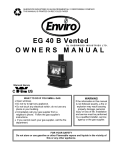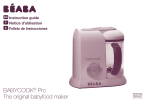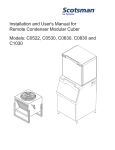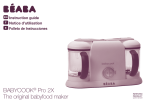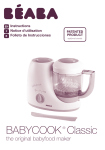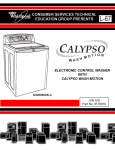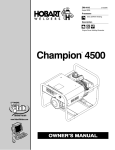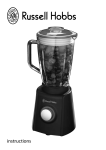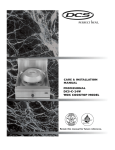Download DCS DW-24SS User's Manual
Transcript
Dynamic Cooking Systems, Inc. THE PROFESSIONAL DISHWASHER Use and Installation Guide Models: ■ DW-24SS A Message To Our Customers Thank you for selecting this DCS Professional Dishwasher. Because of its unique features, we have developed this Use and Installation Guide. It contains valuable information on how to properly operate and maintain your new Dishwasher for years of safe and enjoyable cooking. To help serve you better, please fill out and return the Ownership Registration Card and keep this guide handy, as it will help answer questions that may arise as you use your Dishwasher. For your convenience, product questions can be answered by a DCS Customer Service Representative by phone: 1-888-281-5698, or Fax: 714-372-7003, or by mail: DCS Attention Customer Service, 5800 Skylab Road, Huntington Beach, CA 92647 WARNING BEFORE USING THE APPLIANCE: Carefully read all the instructions contained in this manual. Installation must be performed by a qualified technician, in compliance with the regulations in force. This appliance is intended for domestic use, and complies with the EEC Directives 73/23, 89/336 (including 92/31 and 93/68) currently in force including the prevention and elimination of radio frequency interference. The appliance is designed for the following purpose: Washing and drying of dishes; any other use shall be considered improper. The manufacturer declines all responsibility for uses other than those described above. WARNING The plug on the power cord and the corresponding socket outlet must be of the same type, and must conform to the regulations in force. Check that the voltage and frequency of the electrical power supply match the ratings on the name plate. Avoid using adapters or shunt connections. Never unplug the appliance by pulling the power cord. • After installation, the plug must remain accessible. • In the event of damage to the power cord, have it replaced by a qualified technician. • After replacing the power cord, make sure that the terminal block compartment cover is closed correctly. PLEASE RETAIN THIS MANUAL FOR FUTURE REFERENCE. 1 Table Of Contents SAFETY PRACTICES & PRECAUTIONS...............................................................................3 INSTALLATION INSTRUCTIONS..............................................................................................4 USER INSTRUCTIONS ................................................................................................................5-22 Description of the Controls ...............................................................................................5 Program Cycle Chart............................................................................................................6 Program Features...............................................................................................................7-8 Energy Savings Tips, Peekaboo Feature.............................................................................9 Moving the Facing Panel.....................................................................................................10 Detergents and Rinse Aids..........................................................................................11-12 Dish Loading Tips and Warnings ................................................................................13-17 Cleaning and Maintenance .................................................................................................18-19 Troubleshooting .....................................................................................................................20-22 WARRANTY ............................................................................................................................................23 SERVICE .....................................................................................................................................................24 2 Safety Practices & Precautions The appliance must be provided with an ground connection in accordance with the electrical safety regulations in force. The manufacturer declines all responsibility for damage to persons or property resulting from the failure to ground the appliance or from a defective ground connection. If the appliance is not connected to the electrical power supply by means of a plug, it is necessary to install an isolation switch with a contact opening gap of at least 3mm. If the appliance is installed on a carpeted or covered floor, ensure that the openings on its underside are not obstructed. • The NAME PLATE featuring the technical data, serial number and markings are visibly positioned on the inner edge of the door.The name plate on the inner edge of the door must never be removed. • If the appliance is not connected to the electrical power supply by means of a plug, it is necessary to install an ISOLATION SWITCH with a contact opening gap of at least 0.118 in. • The PLUG on the power cord and the corresponding socket outlet must be of the same type, and must conform to the regulations in force. Check that the voltage and frequency of the electrical power supply match the ratings on the name plate. Avoid using adapters or shunt connections. NEVER UNPLUG THE APPLIANCE BY PULLING THE POWER CORD. • If the appliance is connected to a circuit protected by fuse, 15 A FUSES have to be used. • After installation, the plug must remain accessible. In the event of DAMAGE TO THE POWER CORD, have it replaced by a qualified technician. After replacing the power cord, make sure that the terminal block compartment cover is closed correctly. • If the appliance is INSTALLED ON A CARPETED OR COVERED FLOOR, ensure that the openings on its underside are not obstructed. • DO NOT leave the discarded packaging materials unsupervised within the home. • Always switch off the dishwasher after each use to avoid wasting electricity. • DO NOT use appliances which have been damaged during transit, if in doubt consult your dealer. The appliance must be installed and connected in accordance with the instructions provided by the manufacturer or by a qualified technician. • DO NOT introduce solvents such as alcohol or turpentine which may cause an explosion. • DO NOT load dishes that are soiled with ash, wax or paints. • DO NOT lean or sit on the open door. This may cause the dishwasher to overturn. • DO NOT drink the water residues which may be present inside the dishes or dishwasher at the end of the washing program and before the drying cycle. Obsolete appliances must be rendered unusable. Cut off the mains power cord after unplugging it from the wall outlet, and make safe any components which might be dangerous for children (locks, doors, etc.). The appliance must then be taken to a sorted waste collection site. In the event of a fault, disconnect the dishwasher from the electrical power supply and shut off the water tap. Then call a qualified technician. The appliance is intended for use by adults. Do not allow children to come near or play with the dishwasher. Keep children away from detergents and from the open dishwasher door. The packaging materials (plastic bags, polystyrene, metal bars, etc.) must not be left within the reach of children. Keep children away from the open dishwasher. The appliance may contain residues of detergent which can cause irreversible damage to the eyes, mouth, and throat, as well as possible death by suffocation. 3 Installation Instructions INSTALLATION AND HOOK UP Remove the polystyrene basket retainers. Position the appliance in the desired place of installation. The back or sides of the dishwasher may be placed up against walls or other furniture units. If the dishwasher is installed near a heat source, fit the special insulating panel to prevent overheating and malfunction of the appliance. To ensure stability, install integrated or built-under dishwashers only under continuous countertops, and screw them to adjacent units. To facilitate the installation procedure, the intake and drain hoses can be positioned in any direction; make sure that the hoses are not kinked, crushed or pulled too tightly. Level the appliance on the floor using its adjustable feet. This operation is essential for ensuring correct operation of the dishwasher. NOTE - Some models are equipped with only one adjustable foot at the rear, which can be adjusted by turning the screw on the lower front part of the appliance. WATER SUPPLY CONNECTION Connect the intake hose to a cold water supply with 3/4” gas thread. Inserting the filter A supplied with the dishwasher, and taking care to screw it firmly into the tap. In dishwashers equipped with the aquastop device, the filter is already fitted inside the threaded ring. The dishwasher can also be connected to a hot water supply not exceeding 140°F. Supplying the appliance with hot water cuts down the washing time by approximately 20 minutes, but slightly reduces its effectiveness. Make the connection to the domestic hot water supply using the same procedure described for connecting to the cold water supply. DRAIN CONNECTION Insert the dishwasher’s drain hose into a drain pipe having a diameter of at least 1-9/16 in., or alternatively, place it inside the kitchen sink using the plastic support provided, taking care not to crush or excessively bend the hose. It is important to prevent the hose from coming loose and falling. For this purpose, the plastic support is equipped with a hole for tying it to the pipe or water tap. The free end should be positioned at a height of between 11-13/16 in. and 39-3/8 in., and should never be submerged in water. If a horizontal drain extension hose is used (for a maximum of 9.84 ft.) the drain hose can be placed at a maximum height of 33-7/16 in. from the ground. CAUTION: Preventing the risk of clogging or damage: If the water pipe is new or has not been used for a long period of time, before connecting to the water supply check that the water is clear and free of impurities to prevent damage to the appliance. 4 User Instructions DESCRIPTION OF THE CONTROLS Upper panel All the dishwasher controls are grouped on the upper panel. 1 ON/OFF BUTTON 2 PROGRAM SELECTION BUTTON 3 DELAYED START BUTTON 4 ECONOMY PROGRAM SELECTION BUTTON 5 ECO DRYING CYCLE BUTTON 6 1/2 LOAD WASH SELECTION BUTTON (on some models only) 7 INFORMATION DISPLAY INFORMATION DISPLAY The dishwasher is equipped with a practical DISPLAY which provides information on the programmed dishwasher functions. CURRENT PROGRAM INFORMATION (remaining time indication and warnings for the most common problems) DELAYED START INDICATOR LIGHT RINSE AID WARNING LIGHT ECONOMY PROGRAM SELECTION LIGHT ECO DRYING CYCLE LIGHT (on some models only) HALF-LOAD INDICATOR LIGHT (on some models only) SETTING THE WASHING PROGRAM AND SWITCHING ON To select the most suitable program for the dishes to be washed refer to the table below, which indicates the most appropriate program according to dish type and degree of soiling. 5 User Instructions After choosing the most suitable washing program using the table provided: • Press the ON/OFF key (1) and wait for the information display (7) to come on. • Press the Program selection button (2) several times, until the information display (7) shows the number corresponding to the program of choice. • Close the door; the machine will automatically begin the washing program after the sounding of the acoustic device. NOTE: “P0” on the display means than no washing program has been selected. This message remains until the program selection button (2) is pressed; at this point the number of the last program used will appear. Each time the button is pressed again, the program numbers will move on from that point forward. All programming operations are accompanied by a short confirmatory beep; if you do not hear anything when you press a button, the function concerned is not available in the program selected. Only run the soak program with half loads. The half load option (6) is available for all programs except the soak program. Before starting program (8) check that the door of the detergent dispenser is open. NOTE: The ECO drying cycle option is available. This activates the ventilation system which allows the dishes to be dried at lower temperatures (energy saving). With this option enabled, the program takes longer PROGRAM CYCLE CHART CYCLE N. ECO BUTTON TYPE AND DEGREE OF DIRT ON DISHES AMOUNT OF DETERGENT TBS PROGRAM SEQUENCE PREWASH WASH COLD RINSE HOT RINSE DRYING ECO DRYING - SOAK 1 - PANS AND DISHES PENDING - COLD - - - - DELICATE 2 - DISHES WITH LIGHT DIRT 1 - 113°F 1 149°F YES DELICATE (ECO) 2 SLIGHTLY SOILED DELICATE ITEMS 1 - 113°F 1 131°F YES LIGHT 3 - DISHES WITH LIGHT DIRT 1 - 113°F 2 - - NORMAL 4 - NORMALLY SOILED PANS AND DISHES 1 COLD 149°F 1 149°F YES NORMAL (ECO) 4 NORMALLY SOILED DISHES 1 - 149°F 1 149°F YES ECO WASH 5 NORMALLY SOILED PANS AND DISHES, INCLUDING DRIED-ON RESIDUE 1 COLD 131°F 1 149°F YES ECO WASH (ECO) 5 SLIGHTLY SOILED DISHES WITH DRIED-ON RESIDUE 1 COLD 154°F 2 154°F YES HEAVY 6 VERY DIRTY PANS AND DISHES, EVEN WITH DRIED-ON DIRT 1 - 154°F 2 154°F YES HEAVY (ECO) 6 NORMALLY SOILED PANS AND DISHES WITH DRIED-ON STARCH DEPOSITS 1 - 154°F 2 154°F YES POTS N PANS 7 - HEAVILY SOILED PANS AND DISHES WITH DRIED-ON STARCH DEPOSITS 1 113°F 158°F 2 154°F YES RINSE (**) 8 - DISHES THAT NEED “FRESHENING UP” - - - 1 149°F YES - - - Only run the soak program with half loads. The HALF LOAD option (6) is available for all programs except the soak program. (*) Reference program as per EN 50242 standard (program recommended when using “new generation” detergents containing enzymes). (**) Before starting program 8 check that the door of the detergent dispenser is open. (−) not present. In programs containing the symbol, the ECO drying cycle option is available.This activates the ventilation system which allow the dishes to be dried at lower temperatures (energy saving).With this option enabled, the program takes longer. Please note that the amount of detergent suggested is to be used as guideline only. Please follow your packaging instructions. 6 User Instructions TABLE FOR CERTIFICATION BODIES Reference standard Reference program IEC 436 EN 50242 NORMAL program (4) (*) ECO BIO program (5) 12 place-setting 12 place-setting A B 1 tablespoon 1 tablespoon Load Type of detergent Amount of detergent Rinse aid setting Depending on the model 3/4 or 4/6 EN 50242 DISABLING THE ACOUSTIC DEVICE The dishwasher’s electronic system allows you to: • Disable the acoustic device which confirms all dishwasher programming and operating steps. • Adapt the dishwasher’s water filling system to the mains water pressure. PROGRAMMING PROCEDURE: • Press the PROGRAM SELECTION (2) and DELAYED START (3) buttons simultaneously for 3 seconds until the DISPLAY (7) shows the symbol of the parameter to be modified. • Press the DELAYED START BUTTON (3) to modify the parameter. • Press the PROGRAM SELECTION BUTTON (2) to change the parameter for modification and/or to exit from the procedure. DISPLAY PARAMETER ADJUSTABLE VALUE EFFECT ACOUSTIC DEVICE 0 1 0 1 OFF ON NORMAL LOW WATER PRESSURE 7 User Instructions WASHING PROGRAMS The dishwasher is equipped with a control panel and an information display, described in on page 5. “Description of the controls”, from which it is possible to carry out all the power switch-on, switch-off and programming operations. Before starting a washing program make sure that: • • • • • The The The The The water supply tap is open. correct amount of detergent has been added to the dispenser. baskets have been correctly loaded. spray arms are able to rotate freely and without obstruction. dishwasher door is securely closed. HALF LOAD WASH This function is especially suitable for loads up to six (6) place settings and allows saving of water and electricity. It is controlled by the half load button (6) allows washing in the upper basket only. IMPORTANT: At the end of the program remember to deactivate the function to ensure the next wash is not also carried out in half load mode by mistake. CAUTION: A cutlery basket can be placed in the upper basket, while the lower basket must be left empty.There is no point in loading dishes and cutlery in the lower baskets, since the jet of water will only reach the upper basket. EXIT PROGRAM To exit the program being carried out, after opening the door select program “P0”. When the door is closed the dishwasher will skip to the end of the program. MODIFYING PROGRAM To modify the current program, after opening the door select the new program. When the door is closed the dishwasher will start the new program automatically. DELAYING PROGRAM The start of the washing program can be delayed from a minimum of 1 hour to a maximum of 9 hours; this allows you to operate the dishwasher at the time of day of your choice. When the delayed start button (3) is pressed, the display (7) will show first the duration of the program set and then the number of hours (9,8,....1) of delay with which it is to be started. The number of hours will disappear automatically if the keypad is not used for five (5) seconds or if any other button except the delayed start button (3) is pressed. When the door is closed the dishwasher will perform a pre-wash, after which the program delay set previously will start. To check the time left before the program starts, simply press the corresponding button once. 8 User Instructions ENERGY SAVING TIPS • • • • • • Always try to run the dishwasher fully loaded. Do not wash the dishes in running water. Use the washing program that is most appropriate for each type of load. Do not carry out any preliminary rinsing. If available, connect the dishwasher to a hot water supply up to 140°F. When possible, disable the drying cycle and leave the door open at the end of the washing cycle. The residual air and heat will dry the dishes perfectly. TO CUT DOWN ON DETERGENT CONSUMPTION The phosphates contained in dishwasher detergents are harmful to the environment. To avoid using excessive amounts of detergent and to save on electricity, observe the following: • Separate the more delicate items from dishes that are more resistant to aggressive detergents and high temperatures. • Do not pour the detergent directly on the dishes. If it is necessary to open dishwasher door during the washing cycle, there will be a one (1) minute delay before the program can be resumed. After correctly closing the door, the washing program will start again from where it was interrupted. This operation may negatively affective the progress of the washing cycle. REMOVING DISHES At the end of the washing program (the end of the washing program is signalled by a short intermittent beep and the appearance of “P0” on the display), wait at least twenty (20) minutes before removing the dishes, to allow them to cool down. To prevent any water droplets on the upper basket from falling on the dishes in the lower basket, it is advisable to unload the lower basket first, and then the upper basket. SLIDING FACING PANEL (PEEKABOO FEATURE) This dishwasher is equipped with a front display carrying the same information as the top control panel. A system which moves the facing panel allows this display to be revealed when the dishwasher door is closed; to do this follow the instructions in the moving the facing panel point. While the program is in progress, the display shows the time left before it ends (hours alternating with minutes), and the symbols described in page 5 “Description of the Controls” and any error warnings E2, E3, . . .E6 also appear.The LUMINOUS LOGO remains off throughout the cycle and illuminates when it ends. LUMINOUS LOGO FRONT DISPLAY 9 User Instructions MOVING THE FACING PANEL (PEEKABOO) To lower the facing panel and reveal the FRONT DISPLAY, proceed as follows: • Make sure that the door is closed. • Push the facing panel down until the whole of the display is visible.To return the facing panel to the normal position, push it back up. WARNING: • The facing panel can only be lowered with the door closed. • Once the facing panel has been lowered the door cannot be opened (see diagram). • Before opening the door of the dishwasher make sure that the facing panel is in the high position. • Never lower the facing panel and close the door simultaneously, first close the door, then lower the facing panel. • Never raise the facing panel and open the door simultaneously, first bring the facing panel to the high position, then open the door. COMPLIANCE WITH THE INSTRUCTIONS PROVIDED ABOVE ENSURES THE CORRECT OPERATION BOTH OF THE SLIDING SYSTEM OF THE FACING PANEL AND OF THE DISHWASHER ITSELF. 10 User Instructions ADDING THE DETERGENT To open the detergent dispenser cap, lightly press the program button. Add the detergent and close the cap carefully. During the washing cycle, the dispenser will be opened automatically. • When a SUPER program is selected, in addition to the normal dose of detergent, it is necessary to add an additional amount inside compartment G or H. • Use only detergents specially formulated for dishwashers. For optimal washing results it is important to use a good quality detergent. • The detergent packs must be sealed and stored in a dry place to prevent the formation of lumps which may negatively affect washing results. Once opened the detergent packs should not be kept for too long, otherwise the detergent loses its effectiveness. • Do not use detergents formulated for washing dishes by hand, because they produce a great deal of foam and may negatively affect the operation of the dishwasher. • Add the correct amount of detergent. An insufficient amount of detergent will result in a partial removal of dirt from the dishes, whereas an excessive amount is wasteful and does not improve the washing results. • There are various types of detergents available on the market - liquid, powder and tablet forms characterized by different chemical compositions: some contain phosphates, whereas others are phosphate free and based on natural enzymes. - Detergents containing phosphates are more effective against grease and starch at temperatures above 140°F. - Enzyme detergents, on the other hand, also effective at lower temperatures (from 104°F to 131°F) and are more easily biodegradable.With enzyme detergents it is possible to obtain at low temperatures comparable results to those which can only be achieved at 149°F using traditional detergents. For the safeguarding of the environment we recommend the use of phosphate- and chlorine free detergents. CAUTION: The introduction of detergent into the rinse aid dispenser, even in liquid form will damage the dishwasher. 11 User Instructions USING THE RINSE AID AND DETERGENT DISPENSERS The detergent and rinse aid dispensers are situated on the inner part of the door: the detergent dispenser is on the left, and the rinse aid dispenser is on the right. With the exception of the SOAK program, before every washing cycle it is necessary to add the required amount of detergent of the detergent dispenser. The rinse aid, on the other hand, should only be added as required. ADDING THE RINSE AID The rinse aid helps the dishes dry faster and prevents the formation of scale deposits and staining; it is automatically added to the water during the final rinse cycle, from the container situated on the inner side of the door. • Open the door • Rotate the container cap counterclockwise by 1/4 of a turn and remove it. • Add the rinse aid until the container is full (approximately 0.59 cup or 4.73 FL. OZ).The optical level indicator on the side of the cap should be completely obscured. Refill the rinse aid when the optical level indicator becomes clear again, or when the rinse aid warning light illuminates. • Replace the cover and turn it in a clockwise direction. • Use a cloth to remove any spillage of rinse aid which might lead to the formation of excess foam. ADJUSTING THE RINSE AID DISPENSER SETTING The dishwasher is factory set for medium water hardness. However it possible to change the setting by turning the dispenser’s selector to the desired position: the amount of rinse aid dispensed is proportional to the selector position. The setting must be increased when the washed dishes appear dull or have circular staining. • To adjust the rinse aid setting, rotate the dispenser cap through a quarter turn in an counterclockwise direction and remove it. • Then use a screwdriver to rotate the rinse aid selector to the desired position. • Replace the cap, turning it clockwise. • The amount of rinse aid must be increased if the washed dishes appear dull or feature circular stains. • If, on the other hand, the dishes are sticky or have white streaks, it is necessary to reduce the rinse aid setting. 12 User Instructions GENERAL WARNINGS AND RECOMMENDATIONS Before using the dishwasher for the first time, it is advisable to read the following recommendations concerning dish types to be washed and their loading. There are generally no constraints on the washing of domestic dishes, but in certain cases it is necessary to take their characteristics into account. Before loading the dishes into the baskets it is necessary to: • Remove coarse food remains: e.g. bones, fish-bones, etc. which may clog the filter or damage the wash pump. • Soak any pots or pans with burnt-on food remains on the bottom to facilitate removal, then load them into the LOWER BASKET. If a small quantity of dishes has to be washed, use the “1/2 load wash” option; this saves electricity and water. Remember to load the upper basket only; the lower basket must be left empty. There is no need to pre-wash the dishes under running water before loading them into the baskets since this only wastes water. Correct loading of the dishes helps ensure optimal washing results. WARNING: • Make sure that the dishes are securely in place so that they cannot tip over or obstruct the rotation of the spray arms during the washing cycle. • Do not place very small objects in the baskets as these could fall and obstruct the spray arms or the wash pump. • Containers such as cups, bowls, glasses and pots should always be loaded with the opening facing downwards and with any cavities at an angle, to allow the water to drain out. • Do not stack dishes or place them in such as way that they cover one other. • Do not place glasses too close together because they may knock against each other and break, or there might be staining at the point where they touch. MAKE SURE THAT THE ITEMS BEING WASHED ARE DISHWASHER-SAFE. Items which are not dishwasher-safe: • Wooden dishes, pots or pans: these may be damaged by the high washing temperatures. • Handcrafted items: these are rarely suitable for washing in a dishwasher.The relatively high water temperatures and the detergents used may damage them. • Plastic dishes: these are not heat resistant and may lose their shape. Heat resistant plastic dishes must be washed in the upper basket. 13 User Instructions • Dishes and objects in copper, tin, zinc or brass: these tend to stain. • Aluminum dishes: items made from anodized aluminum may lose their color • Silverware: silver items may stain. • Glass and crystal: in general, glass and crystal objects can be washed in the dishwasher. However, certain types of glass and crystal may become dull and lose their clearness after many washings. Therefore, for these items we recommend using the least aggressive program available. • Decorated items:The decorated objects available on the market are generally able to withstand washing in the dishwasher, although the colors may fade after a great many washes, If in doubt as to the fastness of the colors, it is advisable to wash just a few items at a time for approximately one month. 14 User Instructions USING THE BASKETS The dishwasher has a capacity of 12 place-settings, including serving dishes. LOWER BASKET The lower basket receives the full force of the lower spray arm, and should therefore be used for the “roughest” items with a heavier degree of soiling. All types and combinations of leads are permitted, provided that the dishes, pots and pans are arranged with all the soiled surfaces exposed to the water jets coming from the bottom. With fixed supports To make the most of the space inside the basket when loading large items, certain models are equipped with tip-up supports for plates in 2 or 4 sections. With tip-up supports LOADING THE LOWER BASKET Carefully load flat plates, soup plates, dessert and serving dishes, positioning them vertically. Pots, pans and their covers must be loaded upside down.When loading soup plates and dessert bowls, be sure to leave a gap between them. Loading examples: 15 User Instructions UPPER BASKET It is recommended to load the upper basket with small-or medium-sized items such as glasses, small plates, tea or coffee cups, shallow bowls and light objects made from heat resistant plastic. If the upper basket is used in the lowermost position, it can also be loaded with serving dishes, provided they are only slightly soiled. With fixed metal cup rack To make the most of the space inside the basket, certain models are equipped with: • A metal cup rack which can be stowed vertically when not in use • Or with two lift-up plastic racks. With mobile plastic cup rack in two sections With mobile metal cup rack LOADING THE UPPER BASKET Load the dishes with the top side facing forwards; cups and concave containers should always be loaded with the opening facing down.The left side of the basket can be loaded with cups and glasses on two levels. In the center section, plates and saucers can be loaded vertically into the supports provided. Loading examples: 16 User Instructions ADJUSTING THE UPPER BASKET The upper basket can be adjusted in two positions, according to the user’s needs and according to the height of the dishes in the lower basket. Proceed as follows: Pull-out version: • Pull out the basket to its limit position. • Rotate pin E on the right-hand guide through 90°. • Push the guide so as to disengage the wheels. • Llift the basket and insert the lower pair of wheels into the guide. • Replace the retainer in its original position. Push-button version: • Pull out the basket to its limit position and pull the right side upwards. At this point it is possible to load larger sized plates into the lower basket. • To return to the original position, pull out the upper basket again and press the release lever. CUTLERY BASKET • This varies in shape according to the model and features either a single compartment or separate compartments. • The cutlery should be arranged in an orderly manner inside the basket, with the handles pointing downwards.Take care during loading to avoid injury from the knife blades. • The basket is suitable for all types of cutlery, except those long enough to interfere with the upper spray arm. Ladles, wooden spoons and cooking knives can be place in the upper basket, making sure that the knife blades do not protrude from the basket. 17 User Instructions CLEANING AND MAINTENANCE Before carrying out any work, always disconnect the appliance from the electrical power supply. GENERAL WARNINGS AND RECOMMENDATIONS Avoid the use of acidic or abrasive detergents. • Clean the outer surfaces and door-lining of the dishwasher regularly using a soft cloth moistened with water or with a normal detergent suitable for painted surfaces. • Clean the door gaskets with a damp sponge. • Periodically (once or twice a year) it is advisable to clean the tank and gaskets, using a soft cloth and water to remove any deposits. CLEANING THE WATER INTAKE FILTER • The water intake filter A located at the outlet of the water supply tap needs to be cleaned periodically. • After having closed the water supply tap, unscrew the end of the water intake hose, remove the filter A and clean it delicately under running water. Reassemble filter A in its seat and carefully screw the water intake hose back into position. CLEANING THE SPRAY ARMS • The spray arms can be easily removed for periodic cleaning of the nozzles, to prevent possible clogging.Wash them under running water and carefully replace them in their seats, checking that their rotary movement is in no way impeded. • To remove the upper spray arm, unscrew locking ring R. • To remove the lower spray arm, simply lift it upwards. CLEANING THE ORBITAL SPRAY ARM • To remove the ORBITAL spray arm, grip it by its longer end, lift it upwards and then detach the two rotary arms. • Wash the arms under running water an carefully replace them in their seats, checking that their rotary movement is in no way impeded. 18 User Instructions CLEANING THE FILTER UNIT • It is advisable to periodically inspect the center filter C and, if necessary, to clean it.To remove the filter, grip the tabs, turn them counterclockwise and lift upwards. • Push the center filter D from the underside to remove it from the micro-filter. • Separate the two parts which make up the plastic filter. • Remove the center filter by lifting it upwards. GENERAL WARNINGS AND RECOMMENDATIONS FOR CORRECT MAINTENANCE: • The filters should be cleaned under running water using a stiff brush. • It is essential to thoroughly clean the filters according to the above instructions: the dishwasher cannot function if the filters are clogged. • Carefully replace the filters in their seats, to avoid damaging the wash pump. PROLONGED DISUSE: • Run the soak program twice in succession. • Unplug the power cord from the socket. • Leave the door slightly open, in order to prevent the formation of unpleasant odors inside the washing tank. • Fill the rinse aid dispenser. • Shut off the water supply tap. BEFORE STARTING THE DISHWASHER AFTER PROLONGED DISUSE: • Check that there are no deposits of sludge or rust inside the water pipe: if there are, allow the water to run from the water supply tap for a few minutes. • Plug the power cord back into the socket. • Reconnect the water intake hose and open the tap again. 19 User Instructions TROUBLESHOOTING MINOR PROBLEMS In some cases it is possible to remedy minor problems by referring to the following instructions: If the program fails to start, check that: • The dishwasher is connected to the electrical power supply. • There is no power failure. • The water tap is open. • The dishwasher door is properly closed. If water remains inside the dishwasher, check that: • The drain hose is not kinked. • The drain siphon is not obstructed. • The dishwasher filters are not clogged. If the dishes are not being cleaned properly, check that: • The correct amount of detergent has been added. • The dishes are being loaded correctly. • The selected program is suitable for the dish types and their degree of soiling. • All the filters are clean and positioned correctly. • The spray arm nozzles are not obstructed. • There is no object obstructing the rotation of the spray arms. If the dishes fail to dry or remain dull, check that: • There is rinse aid inside the special container. • The rinse aid dispenser setting is correct. • The detergent used is of good quality and has not lost its effectiveness (for example, through incorrect storage, with the box left open). If the dishes show signs of streaking, staining, etc., check that: • The rinse aid dispenser setting is not to high. 20 User Instructions If there are visible traces of rust inside the tank: • The tank is made of stainless steel, and therefore any rust marks are due to external elements (fragments of rust from the water pipes, pots, cutlery, etc.). Special products are commercially available to remove such marks. • Check that the amount of detergent being used is correct. Certain detergents can be more corrosive than others. If after following the above troubleshooting instructions the problem persists, contact DCS Customer Service at (888) 281-5698. WARNING: any operations performed on the appliance by unauthorized persons are not covered by the warranty and shall be paid for by the user. TROUBLESHOOTING (SELF-DIAGNOSTICS) The dishwasher is equipped with a self-diagnostics system that is capable of detecting and signaling a number of possible faults. In the event of a fault or malfunction, before calling for service, we suggest that you first consult the troubleshooting guide below. If the problem persists even after implementing the recommended solutions, call the DCS Customer Service Department after having carried out the following: • Making a note of the message displayed by the self-diagnostics system. • Unplug the power cord from the socket. • Shut off the water supply tap. TABLE OF FAULTS DETECTED BY THE SELF-DIAGNOSTICS SYSTEM FAULT DESCRIPTION E2 The system which limits the water level inside the dishwasher (Level Safety Device) has been tripped. • Since the cause might be a temporary failure, try reprogramming the dishwasher. • If the problem persists, call the DCS Customer Service Department. E3 The dishwasher fails to heat the water. • To reset the appliance, open and close the door. • To determine the cause of this problem call the DCS Customer Service Department. 21 User Instructions E4 The temperature monitoring system has failed. • Switch the dishwasher off, switch it back on and restart the washing program. If the alarm recurs, call the DCS Customer Service Department. E5 The dishwasher fail to draw water. Check that: • The water supply tap is open. • The filter in the water intake hose is not clogged. • The water intake hose is not kinked or bent. Switch the dishwasher off and back on. If the problem is resolved the washing program will resume from where it was halted. If the fault persists, call the DCS Customer Service Department. E6 The dishwasher fails to drain. Check that: • The flexible drain hose is not kinked or obstructed; • The water drain pipe is not obstructed; • The dishwasher filter is not clogged. Switch the dishwasher off and back on. If the problem is resolved, the washing program will resume from where it was halted. Otherwise, if the fault persists, call the DCS Customer Service Department. In the event of error codes not included in this table, call the DCS Customer Service Department. TECHNICAL DATA Width 23-1/2” 23-9/16” Depth measured flush with the outer edge of the control panel Free standing: 23 5/8” Height from 33 1/2” to 34-1/4” Capacity Standard place settings Water supply pressure min. 50 - max. 900 KPa (min. 0.5 - max. 9 bar) Electrical characteristics See rating plate 22 Warranty LENGTH OF WARRANTY All DCS Dishwashers are covered by a full one (1) year warranty. Five (5) years Limited parts. DCS WILL PAY FOR All repair labor and replacement parts, for parts found to be defective due to materials or workmanship. Service must be provided by Authorized Factory Agent during normal working hours. DCS WILL NOT PAY FOR • Installation or start-up • Shipping damage. • Service by an unauthorized agency. • Damage or repairs due to service by an unauthorized agency or the use of unauthorized parts. • Service during other than normal working hours • Improper installation, such as improper hook-up, etc. • Service visits to tach you how to use the appliance; correct the installation; reset circuit breakers or replace home fuses • Repairs due to other than normal house hold use. • Damage caused from accident, abuse, alteration, misuse, incorrect installation or installation not in accordance with local codes • Units installed in non-residential application such as day care center, bed and breakfast centers, churches, nursing homes, restaurants, hotels, schools, etc. This warranty applies to appliances used in residential applications; it does not cover their use in commercial situations. This warranty is for products purchased and retained in the 50 states of the U.S.A., the District of Columbia and Canada.This warranty applies even if you should move during the warranty period. Should the appliance be sold by the original purchaser during the warranty period, the new owner continues to be protected until the expiration date of the original purchaser’s warranty period. This warranty gives you specific legal rights. You may also have other rights which vary from state to state. 23 Service HOW TO OBTAIN SERVICE: For warranty service, contact DCS Customer Service at (888) 281-5698. Before you call, please have the following information ready: • • • • Model number Serial number Date of installation A brief description of the problem Your satisfaction is of the utmost importance to us. If a problem cannot be resolved to your satisfaction, please write or fax us: Write: DCS Attention: Consumer Relations 5800 Skylab Road Huntington Beach, CA 92647 Fax us at: (714) 372-7003 BEFORE YOU CALL FOR SERVICE: 1. Is the circuit breaker tipped or the fuse blown? 2. Is there a power outage in the area? 24 As product improvement is an ongoing process at DCS, we reserve the right to change specifications or design without notice. 5800 Skylab Road, Huntington Beach, CA 92647 Tel: (714) 372-7000 Fax: (714) 372-7001 Customer Service: (888) 281-5698 www.dcsappliances.com Part No. 17387 Rev B Litho in USA 08/2001


























